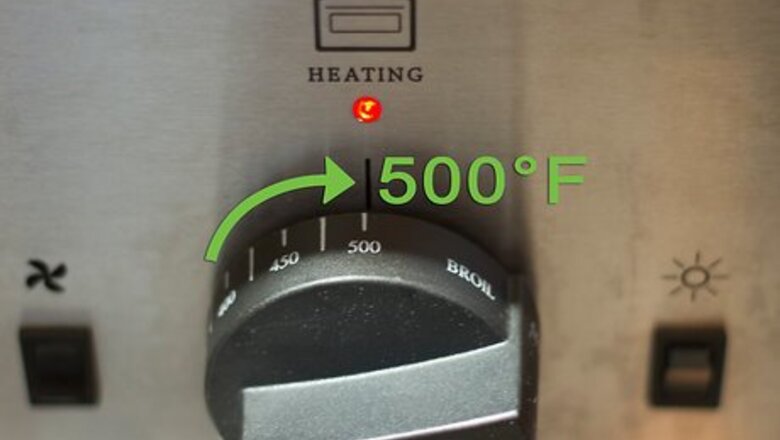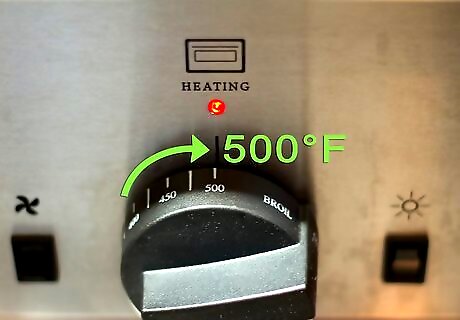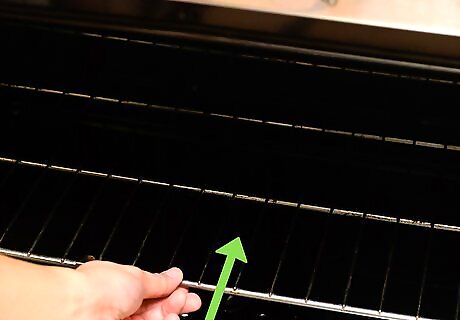
views
Cooking Pizza
Put in a pizza stone if you have one. This one change can make a huge difference. Gas ovens often have less even heat and more moisture than electric ovens. A preheated pizza stone heats your food faster and more evenly, and draws out moisture to prevent soggy crusts. Place it on the lowest or second-lowest rack, or wherever you usually bake your pizzas. Unglazed terra cotta tiles are an effective and much cheaper substitute. However, some clay contains lead or other non-food-safe substances. The risk is lower for tiles made in the U.S. or other countries that regulate lead closely. A cast iron pan is the next best option.

Preheat the oven to its maximum temperature. Professional pizza ovens are much hotter than anything in your kitchen. Crank the oven up to the highest setting — at least 500ºF (260ºC). A pizza stone or heavy cast-iron pan takes longer to heat than your oven, so wait at least 30 minutes. A large pizza stone may need 40–60 minutes. If you want to be sure, check with an infrared thermometer.
Build your pizza. Place your homemade pizza dough on a pizza peel dusted with flour or cornmeal to prevent sticking. Pound the dough into a disk and form the lip of the crust by hand. Toss or pull your pizza until it reaches the desired thickness and size. Brush the lip of the crust with olive oil and add all the toppings. If you don't have a pizza peel, use a rimless baking sheet or an upside-down rimmed sheet, with floured parchment paper over it.
Slide the pizza onto the cooking surface. Shake the pizza peel or baking sheet gently to unstick the dough. Place the end of the pizza peel onto the cooking surface and jiggle it so the pizza starts to slide off. Once the end of the pizza is flat on the stone, jerk the peel back quickly to drop the rest of it. The preheated stone or pan is extremely hot, so be careful. If using a parchment-lined baking sheet, you'll get better char if you slide the pizza off the parchment paper and cook directly on stone or metal. If your pizza is messy with toppings, though, picking up the parchment and dropping it onto the cooking surface is an easier option.
Start checking the pizza after five minutes. If you normally bake your pizzas at a lower temperature, don't rely on your recipe's time estimate. Most homemade pizza only takes 8–12 minutes at 500 to 550ºF (260–285ºC). Take yours out when the top is bubbling and the crust has browned.
Rotate the pizza if your oven cooks unevenly. If your oven has issues with hot spots, rotate the pizza 90 degrees halfway through baking to help it brown evenly. This usually isn't necessary if you are using a pizza stone (and allowed enough time for it to preheat), since the stone's radiant heat should make up for your oven's shortcomings. Do this quickly to minimize heat loss.
Take the pizza out of the oven. Slide the pizza off the pizza stone or pan and onto a plate or cooling rack. Let cool for a couple minutes before cutting. Check the underside of the crust before you remove it. The ideal crust is well-browned, with a few spots of char. If the crust is still pale, let it bake a couple minutes longer.
Troubleshooting Baking Issues

Switch to a different rack if the top and bottom cook at different rates. In a base-heated oven, the crust will cook faster the lower it is. The top of the pizza cooks faster closer to the ceiling, mostly due to faster air currents. Use a lower rack next time if you've been getting brown, bubbly cheese over a pale, doughy crust. Move the pizza to a higher rack if the crust ended up crisper or more charred than you prefer. All ovens are a bit different, so you might get different results, especially if your oven heats from the back or ceiling. Some people even place their pizza stone directly on the floor of the oven, instead of on a rack. This will make an extra-crisp crust, but some pizza stones will crack under that much heat.
Double bake the crust if you can't get it crisp. If your oven runs cold or you prefer a thick crust, it can be difficult to bake the crust completely without burning the toppings. Try baking the pizza for a few minutes with only the sauce, then adding the other toppings and finishing the job.
Cut back on wet ingredients. If your dough is still turning out underdone, use less sauce or switch to a drier cheese. If your oven is particularly cold or uneven, you may need to use less moisture in your dough.
Prick holes to prevent giant bubbles. Thin, cracker-crust dough can bubble excessively. Poke the center of the dough several times with a fork to make holes for air to escape through.
Protect easily burned toppings with cheese. If delicate leafy greens, garlic, or thin slices of meat turn black and bitter, it's not necessarily your oven at fault. These toppings burn easily. Place them under the cheese or under other ingredients to prevent this.
Spread out toppings if the center is underdone. If the crust is perfect but the toppings need more time, make sure the toppings are spread in a thin, even layer.
Finished.

















Comments
0 comment